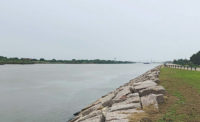Flood design is often reduced to meeting federal and local regulations, but some engineers want more bespoke solutions to keep buildings dry.
“When we deal with contractors, we try to reduce the cost and value-engineer, but we have to meet the standards dictated to us,” says Gene Kennedy, president of Palm Beach, Fla.-based Savannah Trims. The company engineers and manufactures flood-protection systems for major projects across the Eastern Seaboard, including skyscrapers and train stations in New York City and other major metropolitan areas.
As FEMA maps are redrawn and cities pass their own more stringent requirements, Kennedy has seen an uptick in demand to have custom flood protection better integrated into building designs. “As far as we’re concerned, converting curtain wall to a flood protection system is not much more expensive than using standard glazing with removable flood barriers,” he says. “You need a structural footer for those flood panels, so there are hidden costs there."
Over the years, Kennedy says some owners and engineers in a few cities have realized the importance of planning for flood protection early in the construction process, but it can vary. "Most areas, particularly in New York, it's an accepted part of erecting the building. More times they do not treat it as something extra," he explains. "But in other parts of the country, we get panic calls from engineers, saying they've never done this before, we have these new flood maps, can you help us out."
Some of the engineers that regularly work with Savannah Trims also worry that flood protection is not being designed specifically to the site. “It makes no sense to do one-size-fits-all for any given building,” says Robert J. Miller, project manager at Glencoe, Md.-based structural engineer Morabito Consultants. The firm recently did flood design work on JFK Riverwalk and 2400 Market St., mixed-use developments in Philadelphia, that used purpose-built removable flood barriers from Savannah Trims. “You need to treat properties as unique and not see jurisdictions as a monolith."
But there are bright spots. "The most evolution is happening at the local level," observes Miller. In fact, those two mixed-use developments in Philadelphia had to go through the city's special review process for construction in its floodplain, known as the Special Hazard Flood Area.
Miller wishes other municipalities were as serious about flood design as Philadelphia has become in recent years. "They had rules before, but now they have strict protocols to meet with engineers and building owners—to make sure not only minimal FEMA requirements are met, but that [the designs] also clear additional requirements based on elevation," he says. "If a building is along the Delaware River, they say you need to treat it as a unique design for flood risk, not just go off the bigger map."
Miller adds that since his firm has worked on flood-protection projects both as a structural engineer and engineer-of-record, they've seen the problem from two sides. "With flood-proofing requirements becoming more strict in high-hazard areas, we always try to provide all the criteria required for these flood-protection systems," he says. "That works out when we work with someone like Savannah Trims. But other structural engineers don't seem like they know how to provide the information for flood panel manufacturers to design efficiently." This can lead to higher costs, he adds.
Sometimes these shortcomings can just be a lack of specificity on flood elevations for sites with complex topography, but occasionally on projects the engineer is coming in blind, says Frank Morabito, founder and president of Morabito Consulting. "There is basic information like flood levels you expect to find in drawings that doesn't exist," he says. "If it had been thought through by the engineer-of-record, they would be doing better on pricing for [flood-protection]."
But despite some major floods in recent years and new regions being added to new FEMA flood zone maps, Kennedy hasn't seen much competition try to get in on the engineered flood-protection sector. "Things like flood gates and flood barriers are such a specialty, very few enter this market," he says. But Savannah Trims he does admit is seeing rising demand from unexpected parts of the U.S. "We have definitely gone way beyond South Florida. We are finding that we have to be spread all over the country."






Post a comment to this article
Report Abusive Comment